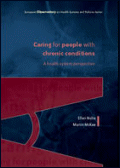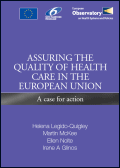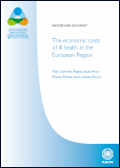SELECTED FOR YOU... DECEMBER 2008: books of the month - working papers
All the Selected for you
BOOKS
Health Targets in Europe : Learning from experience
Wismar M., McKee M., Ernst K., Srivastava D., Busse R.
Copenhague: World Health Organization (WHO), Bureau régional de l'Europe. 2008. 177 p.
As this volume shows, targets, when designed and applied appropriately, constitute an effective governance tool at national, sub-national and local levels. They can help to define policies and set priorities, involve stakeholders and build consensus, guide the collection of intelligence and evaluation, develop legislation and incentives and guide the allocation of funds and purchase of services. Health targets can be particularly instrumental in supporting policies that go beyond the health care services on to other key sectors addressing the roader socioeconomic determinants of health. This book is therefore very much welcomed as it will help to expand our knowledge on the strengths and limitations of targets. It can assist policymakers to better understand what it takes to set targets adequately, how to embed them within health strategies and how best to link them with other governance tools and strategies. The book will also be instrumental in achieving a better understanding of the contextual factors conducive to the successful use of health targets.WHO, together with the other partners of the Observatory, is thus happy to present this volume which will make an important contribution to the arsenal of evidence to improve the governance of health systems.
Caring for people with chronic conditions. A health system perspective.
World Health Organization (WHO). Bureau Régional de l'Europe.
Maidenhead : Open University Press. 2008. 259 p.
The complex nature of many chronic diseases, which affect people in many different ways, requires a multifaceted response that will meet the needs of the individual patient. Yet while there is agreement that the traditional relationship between an individual patient and a single doctor is inappropriate, there is much less agreement about what should replace it.
Many countries are now experimenting with new approaches to delivering care in ways that do meet the complex needs of people with chronic disorders, redesigning delivery systems to coordinate activities across the continuum of care. Yet while integration and coordination have an intuitive appeal, policy makers have had little to help them decide how to move forward.
The book systematically examines some of the key issues involved in the care of those with chronic diseases. It synthesises the evidence on what we know works (or does not) in different circumstances. From an international perspective, it addresses the prerequisites for effective policies and management of chronic disease.
Assuring the quality of health care in the European Union : A case for action.
Legida-Quigley H., McKee M., Nolte E., Glinos I.A.
Copenhague : World Health Organization (WHO), Bureau régional de l'Europe. 2008. 241 p.
This book now examines, for the first time, the systems that have been put in place in all of the European Union's 27 Member States. The picture it paints is mixed. Some have well developed systems, setting standards based on the best available evidence, monitoring the care provided, and taking action where it falls short. Others need to overcome significant obstacles.
The European Union has only limited ability to take action on health care but if free movement of Europe's citizens is to become a reality, an essential measure would be to ensure that appropriate systems are in place to ensure high quality care, even if the approaches taken will vary according to local circumstances. This requires a dialogue between those responsible for funding and providing health care in Europe. This book contributes to this important process.
The economic costs of ill health in the European Region.
World Health Organization (WHO). Bureau Régional de l'Europe. Copenhague.
Copenhague : Organisation mondiale de la santé, Bureau régional de l'Europe. 2008. 33 p.
Evidence on the economic costs of ill health (or, reversely, the benefits of good health) is essential in assessing the economic return on health investment. But understanding what those costs/benefits mean and how they should be measured is equally essential. Public policy discourse on the economic consequences/costs of ill health has been handicapped by considerable confusion about what the term means. Noting that without an a priori definition of the cost concept at issue no meaningful discourse can ensue, we address three economic concepts.
WORKING PAPERS
Health Insurance
Voluntary Private Health Care Insurance Among the Over Fifties in Europe: A Comparative Analysis of SHARE Data. 

Paccagnella O., Rebba V., Weber G.
Padoue : University of Padoue. 2008/10. 30 p.
Using data from SHARE (Survey of Health, Ageing and Retirement in Europe), we analyze the effect of having a voluntary health insurance policy (VPHI) on out-of-pocket (OOP) health spending for individuals aged 50 or more in a host of European countries. We control for self selection into VPHI policy holding, and find that VPHI policy holders do not have lower OOP's than the rest of the population. In Southern European countries and Austria they even spend more. We also find that the main determinants of VPHI are different in each country and this reflects the differences in the underlying health care systems.
Health expenditure
Forecasting the cost of U.S Health Care in 2040. 

Fogel R.W.
Cambridge : NBER. 2008/09. 16 p.
One of the most important debates among health economists in rich nations is whether advances in biotechnology will spare their health care systems from a financial crisis. We must consider that prevalence rates of chronic diseases declined during the twentieth century and that this rate of decline has accelerated. However, health care costs may continue to increase even as the age of onset of chronic diseases is delayed, because the proportion of a cohort living to late ages will increase. The accelerating decline in the prevalence of chronic diseases during the course of the twentieth century supports the proposition that increases in life expectancy during the twenty-first century will be fairly large, but the effect on health care in the U.S. will be modest. The income elasticity for health services is calculated at 1.6, meaning that income expenditures on health care in the U.S. are likely to rise from a current level of about 15 percent to about 29 percent of GDP in 2040.
Drugs
Drug pricing and risk sharing agreements. 

Caprioli S., Levaggi R.
Brescia :Università degli Studi di Brescia. 2008/06. 6 p.
In the recent past some forms of risk sharing agreements have been used in some countries in drug pricing. In this note we present a specific risk sharing agreement on effectiveness and show how such mechanism is going to affect the market in the long run. In particular, we will show how the regulator may create a trade off between expected efficacy and the number of patients to be treated using the pricing formula.
Pharmaceutical pricing and reimbursement policies in Germany. 

Paris V., Docteur E.
Paris : OECD 2008. 63 p.
This paper describes pharmaceutical pricing and reimbursement policies in Germany, considering them in the broader environment in which they operate, and assesses their impact on the achievement of a number of policy goals. Pharmaceutical coverage is comprehensive, with a high level of public funding, and ensures access to treatments. However, recent increases in out-of-pocket payments may impair affordability for the poorest part of the population. Germany does not regulate ex-manufacturer prices of pharmaceuticals at market entry (though distribution margins are regulated for reimbursed drugs). On the other hand, maximum reimbursement amounts (known as reference prices) are set for products which can be clustered in groups of equivalent (generic) or comparable products. Maximum reimbursement amounts are in effect for a large part of the pharmaceutical market covered by statutory health insurance funds (representing 44% of value and 70% of volume in 2006), putting pressure on prices of clustered products. In addition, across-the board price reductions or freezes have occurred on several occasions, and rebates have been regularly imposed on manufacturers. These measures, along with incentives influencing physicians' prescriptions, have helped Germany to contain the growth of pharmaceutical expenditures. All the same, German pharmaceutical prices have been found to be among the highest in OECD, both for patented and generic drugs, when considered at either the ex-manufacturer or the retail level. The 2007 reform introduced two important changes with the aim of ensuring value for money in pharmaceutical expenditures. First, statutory health funds are allowed and encouraged to contract with manufacturers to obtain lower prices in exchange for a “preferred status” for their drug on their formulary. Second, the Institute for Quality and Efficiency in Health Care will assess the benefits and costs of new drugs with the aim of capping reimbursement prices of new entrants if necessary to ensure that their use is not less efficient than existing therapies. Though these reforms may encourage price erosion in some market segments, they will not address all issues: health insurance funds will remain price takers for new drugs without therapeutic alternatives and losses in transparency will be significant.
Informal care
Informal Care and Labor Supply. 

Fevang E., Kverndokk S., Roed K.
Bonn : The Institute for the Study of Labor. 2008/09. 37 p.
Based on Norwegian register data we show that having a lone parent in the terminal phase of life significantly affects the offspring's labor market activity. The employment propensity declines by around 1 percentage point among sons and 2 percentage points among daughters during the years just prior to the parent's death, ceteris paribus. Long-term sickness absence increases sharply. The probability of being a long-term social security claimant (defined as being a claimant for at least three months during a year) rises with as much as 4 percentage points for sons and 2 percentage points for daughters. After the parent's demise, earnings tend to rise for those still in employment while the employment propensity continues to decline. The higher rate of social security dependency persists for several years.
Primary health care
The US Physician Workforce: Where Do We Stand? 

Cooper R.A.
Paris : OECD. 2008/10. 66 p.
This review surveys trends in physician supply in the United States from 1980 to the present with particular attention to the participation of International Medical Graduates. It discussed the composition of the physician workforce with regards to the number of family practitioners, specialists, women physicians and the aging of the workforce. Changes in the inflows and outflows of the physician workforce are discussed and, in particular, how international migration, retirement, part-time practice and alternative employment have impacted the physician workforce.
The study explores factors that influence the demand for physicians, with an emphasis on economic development, and discusses some of the obstacles that exist in achieving a future supply of physicians that is commensurate with the projected demand. It further explores the relationship between health care spending and GDP in the context of geographic variations and public and private health insurance. The study evaluates past attempts to measure the need for physicians in the United States and it projects the future demand for physicians and the actions to expand the physician workforce. This leads to a review of US policies and regulations regarding medical education licensure, specifically focusing on foreign physicians. Finally, the paper considers implications of physician shortages and the recruitment of physicians from abroad.
The link between health care spending and health outcomes for the new English Primary Care Trusts. 

Martin S., Rice N., Smith P.C.
York : University of York 2008/10. 41 p.
English programme budgeting data have yielded major new insights into the link between health care spending and health outcomes. This paper updates two recent studies that have used programme budgeting data for 295 Primary Care Trusts (PCTs) in England to examine the link between spending and outcomes for several programmes of care. We use the same economic model employed in the two previous studies. It focuses on a decision maker who must allocate a fixed budget across programmes of care so as to maximize social welfare given a health production function for each programme. Two equations – a health outcome equation and an expenditure equation – are estimated for each programme (data permitting). The two previous studies employed expenditure data for 2004/05 and 2005/06 for 295 health authorities and found that in several care programmes – cancer, circulation problems, respiratory problems, gastro-intestinal problems, trauma burns and injury, and diabetes – expenditure had the anticipated negative effect on the mortality rate. Each health outcome equation was used to estimate the marginal cost of a life year saved. In 2006/07 the number of PCTs in England was reduced to 152, largely through a series of mergers. In addition, several changes were made to the methods employed to construct the programme budgeting data. This paper employs updated budgeting and mortality data for the new 152 PCTs to re-estimate health production and expenditure functions, and also presents updated estimates of the marginal cost of a life year saved in each programme. Although there are some differences, the results obtained are broadly similar to those presented in our two previous studies.
International Mobility of Health Professionals and Health Workforce Management in Canada: Myths and Realities. 

Dumont J.C., Zurn P., Church J., Le Thi C.
Paris : OECD. 2008/10. 117 p.
This report examines the role played by immigrant health workers in the Canadian health workforce but also the interactions between migration policies and education and health workforce management policies.
Migrant health worker makes a significant contribution to the Canadian health workforce. Around 2005-06, more than 22% of the doctors were foreign-trained and 37% were foreign-born. The corresponding figures for nurses are close to 7.7% and 20%, respectively. Foreign-trained doctors play an important role in rural areas as they contribute to filling the gaps. In most rural areas, on average, 30% of the physicians were foreign-trained in 2004.
Over past decades the evolution of the health workforce in Canada has been characterised notably by a sharp decline in the density of nurses and a stable density of doctors, which is in contrast with the trends observed in other OECD countries. This evolution is largely the result of measures were adopted at the end of the 1980s and early 1990s in order to address a perceived health workforce surplus. During that time, substantial public spending cuts in the health sector, anticipated cuts in medical and nursing school enrolments, and large layoffs of nurses also took place. In addition more restrictive immigration policies were adopted for doctors and nurses between 1986 and 2002 and more stringent registration procedures were introduced for foreign-trained health professionals.
More recently, concerns about health workforce shortages arose and various measures were adopted to expand and strengthen health workforce supply. This includes larger investment in nursing and medical education, the development of new models of care, a set of policies to improve retention, particularly for nurses, increases in the number of residency positions in family medicine, and the development of the Pan- Canadian Health Human Resources Strategy. Also, migration policies for doctors and nurses became more favourable. Between 2002 and 2006, permanent migration of doctors tripled and temporary migration increased by more than 10%, while for nurses, permanent migration increased by almost 40% and temporary migration decreased by 35%. In addition, significant efforts have been devoted at both the federal and the provincial level to address the barriers and facilitate the licensure process of internationally educated health professionals. Over time the origin countries of migrant health workers changed considerably. The United Kingdom has become less important and source countries like South Africa for doctors and the Philippines for nurses have gained importance.
While, a growing consensus is emerging for achieving greater health workforce self-sufficiency, this objective should be interpreted in the light of the role that migration plays in building Canadian society. Building a sustainable health workforce requires long term financial commitments, continuous monitoring of the health labour market, and coordination between all stakeholders and paying particular attention to policy response processes.
Migration of Health Workers: The UK Perspective to 2006. 

Buchan J., Baldwin S., Munro M.
Paris : OECD. 2008/10. 59 p.
The UK has a population of 56 million, and most healthcare is delivered through the National Health Service (NHS). The NHS employs more than one million staff.
In the late 1990s shortages of skilled staff were a main obstacle to improving services in the NHS. The response by government was to “grow” the NHS workforce. There are four main policy options to “grow” the workforce- increase home based training; improve retention rates of current staff (to reduce need to recruit additional staff); improve “return” of staff currently not practising; and internationally recruit health professionals.
International recruitment was used to achieve rapid growth in the NHS workforce. It was facilitated by fast tracking work permits for health professionals, by targeting recruits in specified countries, using specialist recruitment agencies, and by co-ordinating local level recruitment within the NHS.
NHS international recruitment was also underpinned by a Code of Practice. One key point of the Code is that developing countries should not be targeted for active recruitment by the NHS, unless the government of that country formally agrees.
Whilst the period from 1999 to 2005 was one of unprecedented staffing growth for the NHS in England, from 2005 onwards, this growth in staff numbers came rapidly to an end.
Financial deficits emerged in the NHS from 2004-05 onwards, which the UK Parliament Health Committee attributed, in part at least, to the costs of workforce expansion, and costs of new pay contracts for NHS staff.
There have been subsequent changes in the UK migration policy, which also have impacted international recruitment. Medicine, nursing and other health professions are no longer classed as 'shortage' professions. This has lead inevitably to a significant reduction in the inflow of international clinicians to the UK NHS.
The UK situation highlighted the potential for the use of a policy of large scale international recruitment in order to meet staffing growth requirements. Key recommendations from the case study include:
- Migration should only be examined within the overall workforce planning mechanism in use at national level.
- Migration should not be used in isolation, or regarded as a cheap option, with “expendable” migrant health professionals.
- The role of recruitment agencies should be monitored or regulated.
- Bilateral agreements may be an effective way of managing the migration process between a source and destination country. DELSA/ELSA/WP2/HEA(2008)5 7
- A country level code, in a country where most employers and recruitment agencies are bound by the code, can be of some effect in managing the process of recruitment in an “ethical” and efficient way.
- There needs to be more effective monitoring of flows of health workers if a multinational code is to be implemented with any effect.
- In relation to active international recruitment, the recent evidence from England would suggest it can be an effective mechanism for rapidly scaling up the workforce- but that the very rapid pace requires careful monitoring if it is not to overshoot any planned targets for growth.
- Active international recruitment must also be carefully integrated within the overall workforce planning approach, so as to be fully effective.
Health care systems
The Sustainability of European Health Care Systems: Beyond Income and Ageing. 

Pammolli F., Riccaboni M., Magazzini L.
Verone : Verone University. 2008/10. 26 p.
During the last thirty years health care expenditure (HCE) has been growing much more rapidly than GDP in all OECD countries posing increasing concern on the long-term sustainability of current trends. Against this background, we look at the determinants of HCE in European countries, explicitly taking into account the role of income, the effect of ageing population, life habits, technological progress, as well as institutional and budgetary variables. Our results show that the current trend of increasing HCE is rooted in a set of highly differentiated factors. Ageing population is usually regarded as a key driver of HCE in Europe. However, increased life expectancy and decreased fertility rate only tells part of the story. Increased income levels also lead to higher HCE, and the magnitude of the estimated elasticity poses serious concerns about sustainability of current trends. Besides, our results show the deep influence of technological uptake and diffusion, as well as the institutional framework and budget constraints as important factors in explaining HCE growth dynamics. We further control for health habits of the population by looking at the consumption of sugar and of fruits and vegetables. Our results reinforce the need for a political debate at the European level aimed at assuring long-term sustainability and prosperity. The key challenge for Governments is to design pluralistic systems of health care delivery and financing, where a well-balanced mix of public and private financing would put at work market forces to promote investment and innovation, without imposing unsustainable burdens on public budgets or denying care to the disadvantaged population.
Choosing and Successfully Sustaining Competitive Strategies in the European Pharmaceutical Industry. 

Herrmann A.M.
Cologne : Max Planck Institute. 2008/10. 32 p.
It is a central claim of the national competitiveness literature that firms exploit the comparative advantages of their environment by choosing to pursue the product market strategy that is facilitated by national financial- and labour-market institutions. Otherwise, so goes the argument, firms are punished in that strategies receiving no institutional support are less successful and therefore not sustainable in the long run. My analyses of pharmaceutical firms in Germany, Italy and the United Kingdom challenge these arguments on the choice and success of competitive strategies. Given that different measures of strategy success do not indicate that the latter is in line with national institutional advantages, I develop an alternative explanation for the strategy choices of firms. On the basis of my qualitative interviews with managers, I argue that technological opportunities to transform inventions or imitations into marketable products are a primary concern when entrepreneurs choose their firm's strategy. Zusammenfassung Es ist ein zentrales Argument der Literatur zur nationalen Wettbewerbsfähigkeit von Unternehmen, dass sich letztere die Wettbewerbsvorteile ihrer institutionellen Umgebung zu Nutze machen, indem sie diejenigen Produktstrategien wählen, die durch die jeweiligen nationalen Finanz- und Arbeitsmarktinstitutionen gefördert werden. Ansonsten, so ein weiteres Argument der Literatur, werden Firmen dadurch abgestraft, dass institutionell nicht gestützte Strategien langfristig weniger erfolgreich und daher nicht von Bestand sind. Die im Rahmen dieses Projekts durchgeführten Untersuchungen von Pharmazieunternehmen in Deutschland, Italien und Großbritannien lassen Zweifel an diesen Argumenten zu Wahl und Erfolg von Wettbewerbsstrategien entstehen. Da verschiedene Indikatoren von Strategieerfolg nicht darauf hindeuten, dass nationale Wettbewerbsvorteile die Strategiewahl beeinflussen, wird eine alternative Erklärung entwickelt, wie Unternehmen Wettbewerbsstrategien wählen. Auf der Grundlage von qualitativen Interviews mit Managern wird aufgezeigt, dass die technologischen Möglichkeiten eines Unternehmens, Erfindungen oder Imitationen in marktfähige Produkte zu verwandeln, von wesentlicher Bedeutung dafür sind, welche Strategie ein Unternehmer wählt.
Care Supply for Rare Diseases: Some Stakes for an Organizational Innovation within the French Healthcare System. 

Le Chaffotec A., Hirtzlin I., Staropoli C., Menard C.
s.l. : ISRICH. 2008. 25 p.
This paper deals with the organizational change in the provision of care for rare diseases, and the creation of a new structure: the centre of reference for rare diseases (CRMR). It aims to show that this new organization of care introduces a new “authority” within the healthcare organizational structure, by referring of the Transaction costs paradigm and its recognition of hybrid forms. It tackles then several conditions this authority has to fulfill in order to complete CRMR missions and awaited results.



